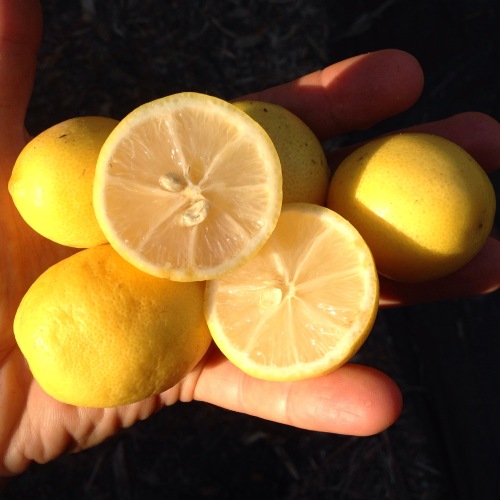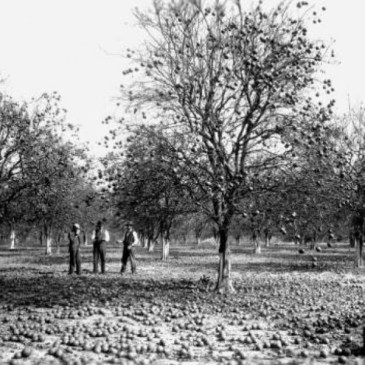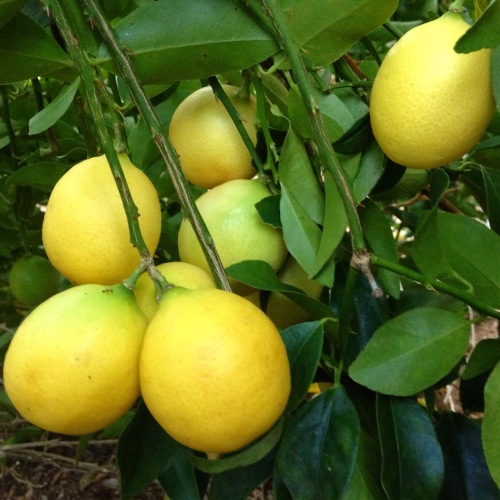
What do you get when you cross the heavenly-tasting, juicy, sour, key lime with the frost-tolerant, sweet-peel kumquat fruit? You get limequat, a delicious, juicy, aromatic, sour, lime-like fruit which has the bonus of having an edible peel. Not only that, but this is a tree which can fruit in areas too cold for pure key limes.
Almost as interesting as limequat is the story of the person who created it. Walter Swingle was a fruit geek of the first order, who in the early 20th century was one of the legendary plant explorers of that era sent by the US Department of Agriculture on a mission to travel the globe in search of useful plant varieties to send back to the US. Along with David Fairchild (today known for having started Fairchild Tropical Garden), and Frank Meyer (famous for introducing the Meyer Lemon), these intrepid plant adventurers voyaged by steamship, train, horse, camel, and on their own two feet to mountains, deserts, jungles, and remote villages all around the world. Wherever they found interesting fruits, nuts, vegetables, grains, beans, bamboos, or timber crops, they packaged up starts of these plants and sent these back to agricultural experiment stations in the US for trial.

I suspect that a large percentage of the crops grown in the US today contain parentage of the plant varieties these explorers collected over a century ago.
Walter Swingle personally introduced the date palm and pistachio nut to the US, as well as introducing the fig pollinator insect that many of the best fig varieties need in order to set fruit. Swingle recognized the dangers of agricultural monoculture, and pushed for preservation of genetic diversity – living collections of a wide variety of crops and their wild relatives.
Swingle took a particular interest in citrus, and he alternated his overseas exploration with work in Florida breeding new citrus varieties, and testing wild relatives of citrus for resistance to disease and environmental extremes. The devastating twin freezes of December 1894 and February 1895 destroyed much of the citrus groves existing in Florida at that time, making growers acutely aware of the importance of introducing cold tolerance into citrus varieties. That’s what Walter Swingle was working on in 1909 when he hand-pollinated flowers of key lime with pollen from kumquat blooms. Kumquat is one of the most cold-tolerant forms of citrus, while key lime is one of the most cold sensitive – the goal was to create a lime-like fruit with kumquat’s cold hardiness.
Swingle planted seeds from the hand-pollinated flowers, and when the seedlings made their own fruit, he was pleased by their fruit quality. In 1913, he released to the nursery trade three varieties from those crosses, which he named after towns in Florida: ‘Eustis’, ‘Lakeland’, and ‘Tavares’.

I’ve got the most experience with the “Lakeland” limequat, and I can report that it’s an outstandingly productive tree, with excellent flavored fruit. ‘Lakeland’ limequats are extremely juicy, with an aroma and taste almost identical to pure Key lime, except not quite as powerful (I’d say the flavor and aroma are about 70% as intense as the flavor and aroma of pure Key lime). The juice is great wherever lime or lemon juice works: salad dressings, in drinks, marinades, on cooked veggies or fish, or added to water and sweetened to make a refreshing “limequat-ade”.
Unlike Key lime, limequat peels are edible and tasty, although maybe not quite as sweet tasting as the skin of pure kumquats. The edible peel makes this a great one for a lime-flavored marmalade. People who like sour flavors eat whole limequats, peel and all.
Limequat trees are extremely productive, over an extended season. One grower I know in the Gainesville, Florida area harvests over a gallon of fruit every week from each of his ‘Lakeland’ limequat trees for many months of the year.
Walter Swingle’s work still has a huge influence on Florida’s citrus industry today. His book classifying citrus fruits and their botanical relatives is still the premier reference book on the subject. Many of the varieties he bred are still widely grown.

Another of his breeding projects to develop more cold-tolerant forms of citrus fruits involved crossing citrus to the extremely cold-hardy related plant Poncirus trifoliata. Although the resulting hybrids didn’t have sufficient eating quality to be grown for their fruits, they turned out to make excellent rootstocks for good fruiting types of citrus – many of the trees in today’s citrus groves in Florida are grafted onto one of these, which is known as “Swingle rootstock”.
I like to imagine Walter Swingle’s reaction if he could see his continuing influence in Florida today. I think he’d be pleased that we’re still using and enjoying many of the fruit varieties he developed, and that there are active programs to collect and maintain germplasm of citrus fruits and their relatives. But I suspect he might be a little perturbed that so little has been done to advance his project of trying to introduce kumquat’s cold tolerance into Key lime. I imagine the words of the Ghost of Swingle: “It took me a grand total of a few hours to make those pollinations back in 1909, and in 108 years not one of you clowns has bothered to take that project any further? WTF?!?”
Thanks Craig,
My interest in a Mexican Avocado project has brought me back to your blog, and going back into the archives brought me to this. Bill Schneider in Devine had said there were limequats, and I have just never been able to find any I could plant. I live in central Texas, not Florida, though.
I’ll look again, with the varieties you name.
LikeLiked by 1 person
Yes, limequat is really an excellent fruit, both in flavor quality and productivity. I’m surprised it’s not more widely grown.
LikeLike
Oh, I see. It’s against the law to ship citrus to Texas, and nobody in Texas has limequats.
sigh…
LikeLike
John Day check with your local university agriculture or master Gardeners program to see if they have a protected citrus planting somewhere. I am near enough to the one in southern at University of California Riverside that I can drive there in an hour and a half. They make available to the farmers and researchers and hobbyists scions of their citrus varieties to graft onto rootstocks to make trees. We can get limequat from them here. You might have a similar program in your state. They do this to keep people from introducing scion wood from other countries which is where the Asian Citrus Psyllid came from that almost destroyed the citrus industry in Florida. We also have local nurseries which sell them. Maybe there is a way for you to get your limequat with certified pest free scionwood.
LikeLiked by 1 person
Great info, thanks for contributing that, Ellen.
LikeLike
Thanks Ellen,
Texas A&M doesn’t seem to have limequat. It’s rare enough. I’m experimenting with various citrus, and preparing to put in 12 Meican avocado trees of seven selected varieties. That has been a lot of preparing of the beds already, and there are many more days of work to come on that project.
John in Austin and Yoakum
LikeLike
I found your website while looking for information about the origin of limequats. The information about Walter Swingle was very helpful. I live in the Big Bend area of North Florida where we can get limequat plants. About 20 years ago I had a Lakeland limequat that was a great producer of delicious fruit for about 15 or 16 years and then the tree died. When I tried to replace it I could not find the Lakeland variety so I tried the Eustis variety twice. The Eustis variety was a big disappointment; fewer fruit, fruit less tasty, and both Eustis plants were not very cold hardy and each died during the second winter. A couple of months ago I found a local plant nursery that had the Lakeland variety and I bought two of them, one about 2 and a half feet tall and one about 6 and a half feet tall. Both are covered with fruit and flowers and the fruit quality is great. I hope the new plants are as cold hardy as the prior Lakeland tree I had.
LikeLiked by 1 person
I’m glad the blog post was helpful. That’s great info, thanks. I’ve only tried the Lakeland limequat, never had the Eustis variety, sounds like I’m not missing much. I hope your new plants are as abundant & cold hardy as the old ones – they should be.
LikeLike
Getting my first fruit, they are more green than yellow, young plant, suggested to me by Steve Leitman PHD, in Tally, for our area, which is Jax. Beach, got the plant at the Home Depot.
LikeLiked by 1 person
Wonderful. I like to harvest when they are yellow, but they’re pretty good even when green. Amazingly productive tree.
LikeLike
I have a 2 year old miniature limequat outdoors in a container. It gets plenty of fruit on it but they are small and they are all yellow on the top and green on the bottom. Is that normal? Should it be left in the container or transplanted into the ground. (This is Tucson, AZ.)
LikeLike
Limequats are available in Southern California, they thrive here. I have the Eustis variety in the ground and for a seven foot tree, it is remarkably productive and the fruit is delicious. I just spotted one in a nursery this morning so they continue to be available.
LikeLike
Good to read all the comments. I have a limequat tree here in Tucson which maybe about 10 years old. (I inherited it from someone who had it in a pot) It has done extremely well, a heavy producer for several months of the year, 8-10ft in height. I keep my family and friends supplied with delicious marmalade and use the juice as a substitute for lime or lemon daily. Once the heat of Summer hits, the fruit can be a little dry however.
LikeLike